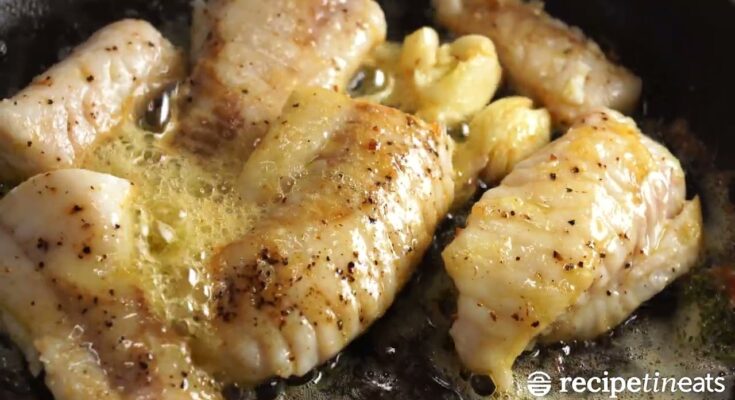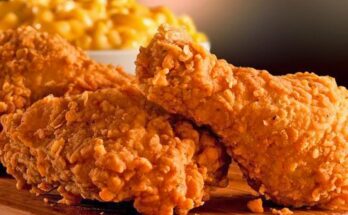Monkfish Recipe: Monkfish, often called the “poor man’s lobster,” has a firm, meaty texture that’s almost identical to lobster. It’s a deep-sea fish known for its large head and wide mouth, but don’t let its appearance fool you—inside is a delicious fillet packed with flavor. The flesh is mild, slightly sweet, and can be prepared in countless ways, making it a favorite among chefs and seafood lovers.
Why Cook Monkfish?
Besides its mouthwatering taste, monkfish is incredibly versatile. You can grill, bake, sear, or stew it. Plus, its firm texture holds up beautifully under intense heat and robust flavors. If you’re looking for a luxurious seafood experience without paying lobster prices, monkfish is the answer.
Ingredients You’ll Need
Basic Ingredients for Monkfish
Here’s a list of essentials to prepare a classic monkfish dish:
- 1 lb monkfish fillet
- 2 tablespoons olive oil
- 1 tablespoon butter
- Salt and pepper to taste
- 2 cloves garlic, minced
- 1 lemon (for zest and juice)
- Fresh herbs like thyme or parsley
These simple ingredients let the natural flavor of the monkfish shine through while adding just enough seasoning to make it pop.
Optional Additions for Flavor
If you want to jazz up the dish:
- Paprika or cayenne for a little heat
- White wine for a delicate sauce
- Capers for a briny punch
- Cherry tomatoes for a burst of sweetness
- Shallots for a hint of richness
Choosing the right extras can completely transform the flavor profile based on your mood and the occasion.
Tools and Equipment Required
Must-Have Kitchen Tools
Before you start, make sure you have:
- Sharp chef’s knife
- Cutting board
- Skillet (preferably oven-safe)
- Tongs
- Baking sheet (if finishing in the oven)
- Meat thermometer (optional but very helpful)
Having these basic tools on hand makes cooking monkfish much easier and safer.
Helpful Extras for Efficiency
For an even smoother experience:
- Fish spatula (thin and flexible)
- Basting brush (for butter or sauce)
- Zester (to easily zest your lemon)
- Kitchen twine (to tie thicker fillets if needed)
Being prepared with the right equipment lets you focus on creating a stunning meal instead of scrambling for tools mid-cook.
Preparing the Monkfish
How to Clean Monkfish
If you’ve bought a whole monkfish tail, cleaning it is your first step:
- Rinse the monkfish under cold water.
- Pat it dry with paper towels.
- Using a sharp knife, carefully remove the grayish membrane covering the fillet. (It can shrink during cooking if left on, making the fish tough.)
Removing the membrane properly is crucial to achieving that signature tender texture.
How to Cut Monkfish for Cooking
Depending on your recipe, you might:
- Leave the fillet whole for roasting.
- Cut it into medallions for pan-searing.
Either way, ensure uniform thickness so the fish cooks evenly. Thicker pieces can be tied with twine to maintain their shape.
Step-by-Step Monkfish Cooking Instructions
Step 1: Marinate the Monkfish
Start by seasoning the fish:
- Sprinkle salt, pepper, and lemon zest over the fillet.
- Drizzle olive oil and massage it into the flesh.
- Optionally, add fresh thyme or parsley on top.
- Let the fish rest for about 15–30 minutes.
This quick marination process allows the flavors to penetrate, giving you a tastier end product.
Step 2: Sear the Monkfish
Now, let’s build that beautiful crust:
- Heat olive oil and butter in a skillet over medium-high heat.
- Once hot, place the monkfish in the skillet.
- Sear for about 2-3 minutes per side until golden brown.
The combination of oil and butter ensures a perfect, crispy exterior while locking in moisture.
Step 3: Finish Cooking Monkfish in Oven
For a perfect finish:
- Preheat your oven to 400°F (200°C).
- Transfer the skillet with the monkfish directly into the oven.
- Bake for about 8–10 minutes or until the internal temperature reaches 145°F (63°C).
The oven gently finishes cooking the fish, keeping it juicy and tender without overcooking.
Serving Suggestions
Best Side Dishes for Monkfish
Pairing monkfish with the right sides can elevate the whole meal experience. Here are some top-notch ideas:
- Garlic Mashed Potatoes: Creamy and rich, they balance the lightness of monkfish perfectly.
- Steamed Asparagus or Broccolini: Fresh greens add a pop of color and crunch.
- Rice Pilaf: Lightly seasoned rice works beautifully to soak up any juices or sauces.
- Grilled Vegetables: Bell peppers, zucchini, and eggplant bring a smoky sweetness that complements the fish.
- Couscous or Quinoa Salad: For a lighter, healthier side, these grains add both texture and nutrition.
Choosing the right side dish can turn your simple monkfish meal into a complete and satisfying dining experience.
Recommended Sauces and Garnishes
A great sauce can take monkfish to the next level:
- Lemon Butter Sauce: A classic that’s buttery, tangy, and delicious.
- Garlic Cream Sauce: Rich and flavorful, ideal for special occasions.
- Tomato Basil Sauce: Fresh and zesty, perfect for summer meals.
- Pesto: A burst of herbal goodness that brings out the fish’s mild flavor.
- Herb Oil: Light and aromatic, giving a gourmet touch.
For garnishes, think chopped parsley, a sprinkle of paprika, or even microgreens for that fancy restaurant look. Presentation matters just as much as taste!
Tips and Tricks for Perfect Monkfish
Common Mistakes to Avoid
Cooking monkfish isn’t complicated, but a few common pitfalls can mess things up:
- Overcooking: Monkfish turns rubbery if you overcook it. Always monitor its internal temperature.
- Skipping the Membrane Removal: Leaving the membrane on will make the fish chewy and tough.
- Not Drying the Fish Properly: Wet fish won’t sear properly, leading to a soggy texture.
- Using Low Heat for Searing: You need a hot pan to get that perfect golden crust.
- Heavy Seasoning: Monkfish has a delicate flavor—don’t overpower it with too many spices.
Avoiding these mistakes ensures your monkfish turns out perfect every single time.
Pro Tips from Chefs
Want your monkfish to taste like it was made by a professional chef? Here are some expert tips:
- Use a Meat Thermometer: Fish is perfectly cooked at 145°F (63°C).
- Baste with Butter: Halfway through searing, spoon hot butter over the fish for extra richness.
- Let It Rest: Give your fish a few minutes to rest after cooking. This locks in the juices.
- Add Fresh Herbs at the End: Don’t cook herbs for too long—add them right before serving for a fresh pop of flavor.
- Experiment with Marinades: Try different marinades like miso, soy, or citrus to give your monkfish an exciting twist.
Master these pro tips, and you’ll be serving restaurant-quality monkfish at home.
FAQs about Monkfish Recipe
What does monkfish taste like?
Monkfish has a mild, slightly sweet flavor that’s often compared to lobster. Its firm, meaty texture makes it ideal for a variety of dishes, from grilling to pan-searing.
Is monkfish healthy to eat?
Yes! Monkfish is low in fat and calories but rich in protein, vitamins, and minerals like selenium and phosphorus. It’s a nutritious choice for a balanced diet.
How should monkfish be cooked?
Monkfish can be baked, grilled, roasted, or pan-fried. Because it’s dense, it holds up well to high heat and bold flavors like garlic, lemon, and herbs.
Why is monkfish sometimes called “the poor man’s lobster”?
Thanks to its sweet taste and firm texture, monkfish offers a similar eating experience to lobster at a fraction of the price, earning it the nickname “the poor man’s lobster.”
How do you know when monkfish is cooked?
Monkfish is fully cooked when it turns opaque and flakes easily with a fork. The internal temperature should reach 145°F (63°C).
Can I prepare monkfish in advance?
You can marinate monkfish ahead of time and store it in the refrigerator. However, it’s best cooked just before serving to maintain its juicy, tender texture.
Is monkfish safe to eat?
When sourced from reputable suppliers, monkfish is safe to eat. Always ensure it’s fresh and cooked properly to avoid any health risks.
Conclusion
Cooking monkfish may seem intimidating at first, but once you dive in, it’s simple, fun, and incredibly rewarding. With its sweet, firm flesh and versatility, monkfish is truly one of the ocean’s hidden treasures. By following this step-by-step guide—choosing quality ingredients, preparing with care, and cooking with attention—you’ll create a dish that’s not just delicious but unforgettable. Whether you’re impressing guests or treating yourself, a well-prepared monkfish meal feels like a five-star experience right at your kitchen table. So next time you’re thinking about seafood, skip the lobster and give monkfish a try—you won’t regret it!



